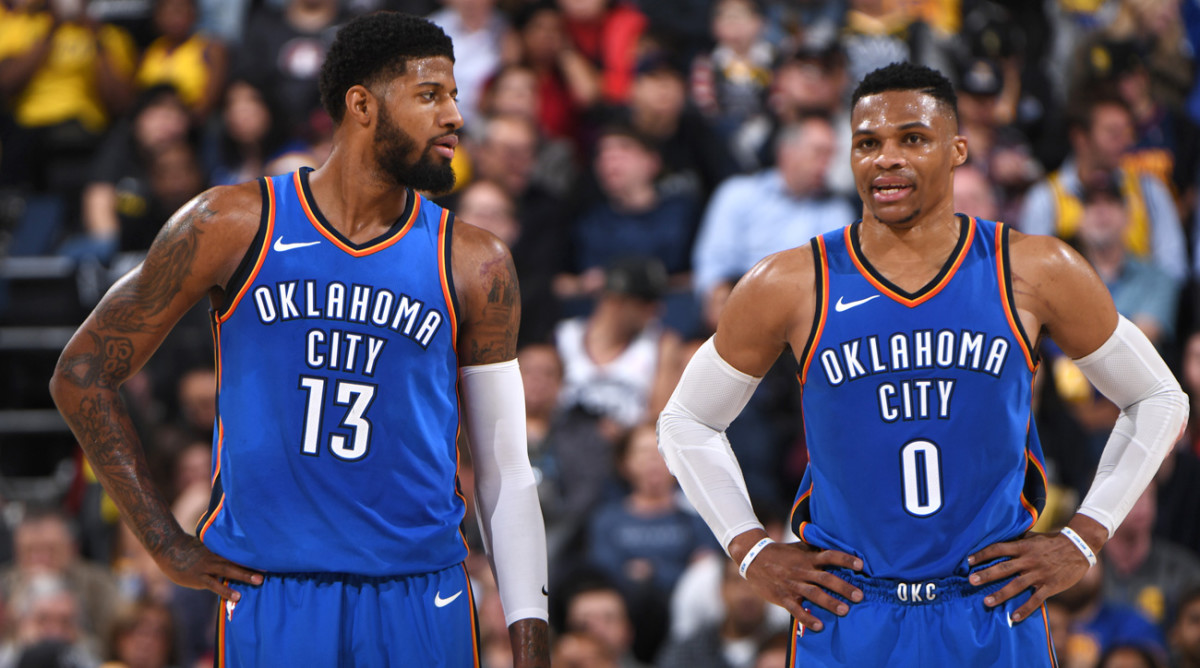Paul George’s Thunder Trial Relies on Partnership With Russell Westbrook

In the high-stakes world of NBA player relations, the Thunder have banked their future on a bond. Paul George was traded from Indiana to Oklahoma City in early July. From that point, George had less than a year to determine whether a future with the Thunder—and a long-term partnership with Russell Westbrook—was the preferred outcome of his long-awaited free agency.
This is a rare opportunity. George has been in the NBA for eight years and never once been a free agent. The NBA has set up barriers to exit for young players that just aren't realistic for stars of George's caliber; between the team control of restricted free agency and the perils of playing out a one-year qualifying offer, most top players are left without much control over their careers for their first seven or eight seasons. That isn't to say that George never wanted to be or stay a Pacer. Only that, ultimately, he had little choice until now.
George has approached the occasion with unprecedented candor. Part of the reason he no longer plays in Indiana is that George has been frank about his pining for Los Angeles—to make good on a childhood dream of leading a team in his hometown.

“It was awesome,” George told the assembled media in L.A. of his in-arena reception at STAPLES Center back in January. “For one, just being home, being in front of friends, family, and then just the respect, the love, the recruitment. It was awesome. It was awesome to get that love.”
That love will be there for George if he wants it. The Lakers will come calling, and in the meantime they'll be tampering and wink-wink-nudge-nudging their way into his consideration. Westbrook, meanwhile, is making the case for the Thunder as George's teammate. The speculative vision of what kind of blank-slate team George might join in Los Angeles is chased, in Oklahoma City, with reality. Every day he goes to work with Westbrook, the best player to ever be on his team. And periodically, the famously reticent Westbrook makes clear to the media and the world just how much he wants George to stay.
Those appeals have real sway. Eight years of playing with Westbrook might have been enough for Kevin Durant, but the world looks different to those who live through the gradual rise and sudden dissolution of a contending team. The best Pacers core of George' tenure folded almost inexplicably. One moment they were pushing LeBron and the Heat for a spot in the NBA Finals. The next, Roy Hibbert and Lance Stephenson—two critical pieces for that team—looked like they might be playing their way out of the league.
And after playing out the string with a host of mediocre rosters since, sharing the court with Westbrook, Steven Adams, and Carmelo Anthony must come as a relief. There have always been quality players around George, but many were overmatched. George Hill is not a proper costar. A 20-year-old Myles Turner wasn't ready to be a team's second-best player, and Jeff Teague had no business in that role. For any criticism one could level against Westbrook, those same concerns do not apply. Stars around the league conspire, in a sense, for what George already has.
My Signature Move: Bradley Beal Explains What Makes His Step-Back So Unstoppable
The Thunder, after some initial wobbling, have found a sort of harmony. Since their uneven first month, Oklahoma City has ranked squarely in the top 10 on offense, per NBA.com. Billy Donovan and his staff have found opportunities for each of the Thunder stars to have their moment. Westbrook, after some convincing, now drives the offense when the starting lineup is in play. When he rests, Anthony (himself a likely free agent in 2018) eats—binging over 30% of the Thunder's possessions. Then George, who comfortably supported both, finds his own creative outlets alongside Oklahoma City's reserves. George has played nearly 400 minutes as a solo star this season—almost three times as many as Westbrook or George. A sampling of his old life can be found there, chased by the satisfactions in working off of a creator like Westbrook.
Surely it is not lost on George that this might be his best role. His offense alone can help carry a decent playoff team through a hard-fought series, but the best course forward calls for a teammate like Westbrook. Taking the burdens of high-volume creation off of George's plate allows him to play a leaner, sharper game. It activates his devastating work off the ball and energizes his defense. It gives his every move an even greater charge. There is both room for George to do more, if the situation calls for it, and a structure that moderates that need.
Whether that—and this trial season in OKC in general—is enough for George is really only a matter of preference. Some buy into the appeal of a new build, others opt for a detailed walkthrough of an existing property. The Thunder aren't exactly a runaway success, but they've shown George the blueprint of what he can reasonably expect: healthy involvement, competitive basketball, and full-throated support.
The stars involved have grown together and learned each other's games, filling out the brochure for the team's eventual pitch. A compelling playoff run would punctuate it.
